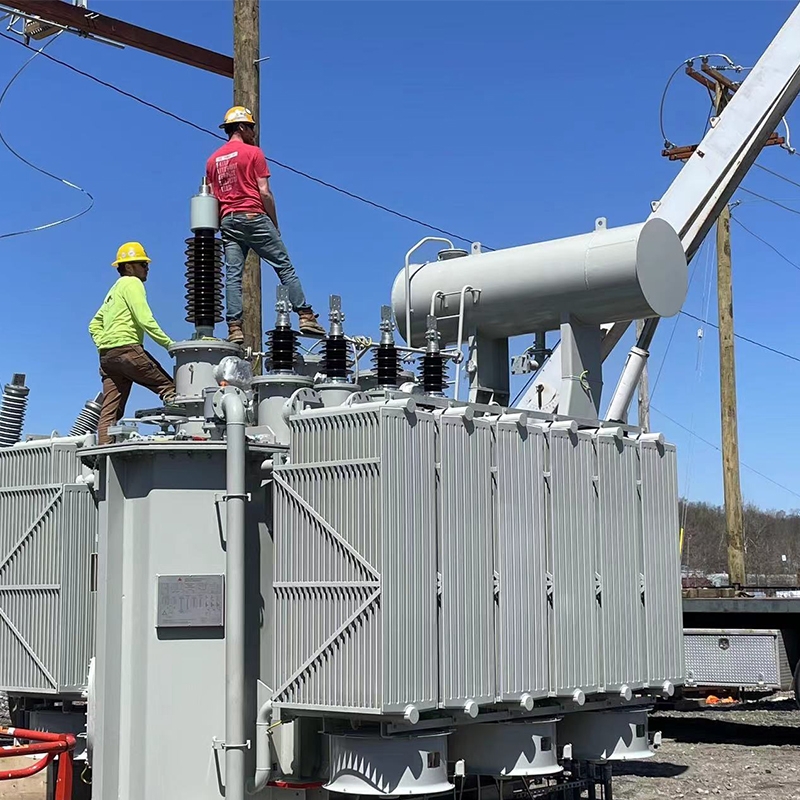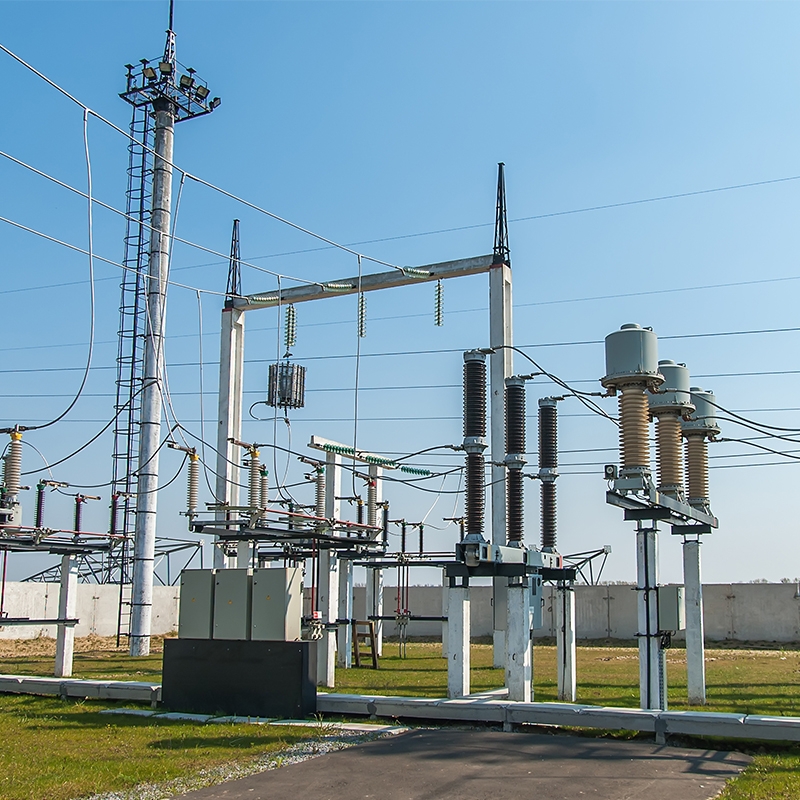Calculation of no-load loss, load loss and impedance voltage of transformers
Transformer loss calculation formula
Active power loss: ΔP = Po+KT β2 Pk
(2) Reactive power loss: ΔQ = Qo+KT β2 Qk
(3) Comprehensive power loss: ΔPz = ΔP+KQ, ΔQQo≈Io%Sn, Qk≈Uk%Sn
In the formula: Qo - no-load reactive power loss (kvar)
Po - No-load loss (kW)
Pk - Rated Load Loss (kW)
Sn - Rated Capacity of Transformer (kVA)
Uk% - Percentage of short-circuit voltage
β - Load factor, which is the ratio of the load current to the rated current.
KT - Load Fluctuation Loss coefficient
Qk - Rated Load leakage magnetic Power (kvar)
KQ - Reactive Economic Equivalent (kW/kvar)
The selection conditions of each parameter in the above formula calculation:
Take KT = 1.05;
(2) When taking the minimum system load for 6kV to 10kV step-down transformers in urban power grids and industrial enterprise power grids, their reactive power equivalent KQ = 0.1kW/kvar;
(3) The average load factor of the transformer can be taken as β = 20% for agricultural transformers. For industrial enterprises, a three-shift system is implemented, and β can be taken as 75%.
(4) The operating hours of the transformer T = 8,760 hours, and the maximum load loss hours t = 5,500 hours;
(5) The no-load loss Po, rated load loss Pk, Io% and Uk% of the transformer are shown in the factory data of the product.
The characteristics of transformer losses
Po - No-load loss, mainly iron loss, including hysteresis loss and eddy current loss;
Hysteresis loss is proportional to the frequency. It is proportional to the power of the hysteresis coefficient of the maximum magnetic flux density.
The eddy current loss is directly proportional to the product of the frequency, the maximum magnetic flux density and the thickness of the silicon steel sheet.
Pc - Load loss, mainly the loss on the resistance when the load current passes through the winding, is generally called copper loss. Its magnitude varies with the load current and is proportional to the square of the load current. (Expressed by the converted value of the standard coil temperature).
Load losses are also affected by the temperature of the transformer. Meanwhile, the leakage flux caused by the load current will generate eddy current losses within the windings and stray losses in the metal parts outside the windings.
The total loss of the transformer ΔP=Po+Pc
The loss ratio of the transformer =Pc /Po
The efficiency of the transformer =Pz/(Pz+ΔP), expressed as a percentage; Among them, Pz represents the output power on the secondary side of the transformer.
Calculation of variable loss electricity quantity
The power loss of a transformer consists of two parts: iron loss and copper loss. Iron loss is related to the operating time, while copper loss is related to the size of the load. Therefore, the lost electricity should be calculated separately.
Calculation of iron loss power: The calculation formula for iron loss power of different models and capacities is: Iron loss power (kilowatt-hours) = no-load loss (kilowatts) × Power supply time (hours)
The no-load loss (iron loss) of the distribution transformer is obtained from the attached table. The power supply time is the actual operating time of the transformer and is determined according to the following principles:
For users with continuous power supply, the entire month is calculated as 720 hours.
(2) In case of power supply interruption or power rationing due to grid reasons, the actual power supply hours provided by the substation to users shall be calculated. It is not allowed to still calculate based on the full month's operation on the grounds that it is difficult to calculate. The time for the self-falling fuse tube to be delivered to the power station after the transformer power outage shall be deducted when calculating the iron loss.
(3) For users equipped with an accumulation clock on the low-voltage side of the transformer, the power supply time accumulated by the accumulation clock shall be calculated.
2. Calculation of copper loss electricity: When the load rate is 40% or less, it is charged at 2% of the monthly electricity consumption (based on the electricity meter reading). The calculation formula is: Copper loss electricity (kilowatt-hours) = Monthly electricity consumption (kilowatt-hours) ×2%
Since copper loss is related to the size of the load current (electricity quantity), when the monthly average load rate of the distribution transformer exceeds 40%, the copper loss electricity quantity should be charged at 3% of the monthly electricity consumption. Monthly electricity consumption when the load rate is 40%.
The calculation formula for load rate is: Load rate = Meter reading electricity quantity/S.T.Cos ¢
In the formula: S - the rated capacity of the distribution transformer (kilovolt-ampere); T - The calendar time for the entire month, taking 720 hours; COS¢- power factor, taken as 0.80.
The transformation losses of Power Transformers can be divided into copper losses and iron losses. The copper loss is generally 0.5%. The iron loss is generally between 5 and 7%. The loss of dry-type transformers is smaller than that of oil-immersed ones.
Total loss: 0.5+6=6.5 \ nCalculation method: 1000KVA× 6.5% =65 kVA
65KVA×24 hours ×365 days = 569,400 KWT (KWH)
The nameplates on the transformer all have specific data.
Transformer no-load loss
No-load loss refers to the power absorbed by a transformer when the secondary side is open-circuited and the primary side is rated at a sinusoidal voltage equal to the rated voltage. Generally, only the rated frequency and rated voltage are paid attention to. Sometimes, the tap voltage and voltage waveform, the accuracy of the measurement system, and the test instruments and test equipment are neglected. The calculated value, standard value, measured value and guaranteed value of the loss have been confused again.
If the voltage is applied to the primary side and there is a tap, if the transformer is a constant flux voltage regulator, the applied voltage should be the tap voltage of the tap position corresponding to the power supply. If it is variable magnetic flux voltage regulation, since the space-time load loss at each tap position is different, the correct tap position must be selected according to the technical conditions and the specified rated voltage must be applied. This is because during variable magnetic flux voltage regulation, a voltage is always applied to each tap position on the primary side.
Generally, the waveform of the applied voltage must be an approximately sinusoidal waveform. Therefore, there are two approaches: one is to measure the harmonic components contained in the voltage waveform with a harmonic analyzer, and the other is to use a simple method, such as a voltmeter with an average value but an RMS scale, to measure the voltage and compare it with the reading of the RMS voltmeter. If the difference between the two is greater than 3%, it indicates that the voltage waveform is not a sine wave, and the measured no-load loss should be invalid according to the new standard requirements.
For the measurement system, it is necessary to select the appropriate test circuit, suitable test equipment and instruments. Due to the development of magnetic conductive materials, the wattage loss per kilogram has been significantly reduced. Manufacturers all choose high-quality, high-permeability grain-oriented silicon steel sheets or even amorphous alloys as magnetic conductive materials. Structurally, they have developed such as stepped joints and fully inclined hole-free. In terms of process, they adopt the non-stacked yoke process. Manufacturers are all developing low-loss transformers, especially the no-load loss has been significantly reduced. Therefore, new requirements are put forward for the measurement system. The capacity remains unchanged, but the no-load loss decreases, which means the power factor of the transformer drops when it is no-load. A small power factor requires the manufacturer to modify and upgrade the measurement system. It is advisable to use the three-watt-meter method, select a transformer of grade 0.05-0.1, and select a watt-meter with low power factor 犄. Only in this way can the measurement accuracy be guaranteed. When the power factor is 0.01 and the phase difference of the transformer is 1, it will cause a power error of 2.9%. Therefore, when making actual measurements, it is also necessary to correctly select the current ratio and voltage ratio of the current transformer and the voltage transformer. When the actual current is much smaller than the current connected to the current transformer, the greater the phase difference and current error of the current transformer, the larger the measured result will be. Therefore, the current drawn by the transformer should be close to the rated current of the current transformer.
In addition, in the design process, the no-load loss calculated by referring to the unit loss and process coefficient of the selected silicon steel sheets in accordance with the prescribed procedures is generally called the calculated value. This value should be compared with the standard value stipulated in the standard or with the standard value or guaranteed value stipulated in the contract. The calculated value must be less than the standard value or the guaranteed value. There should be no margin in the calculation, especially for mass-produced transformers. In addition, the calculated values are only valid for designers or within the design department and have no legal effect. Therefore, the calculated values cannot be used to determine the loss level of the product. The standard values stipulated in the standards or the guaranteed values stipulated in the contracts are legally binding. Products that exceed the standard value plus the allowable deviation, or the guaranteed value (the guaranteed value is equal to the standard value plus the allowable deviation), are considered non-conforming products. When there is a loss assessment system, it is usually pointed out in the contract. Especially for export products, a fine will be imposed if the loss value exceeds the specified limit. The fine for no-load loss is the highest. The loss assessment values of European countries can be found in the 11th issue of the "Transformer" magazine in 1994. A fine of several thousand dollars will be imposed for each kilowatt. This is the legal effect and is directly linked to economic benefits.
The concept of the measured value should also be correctly understood. It is not the reading of the intermeter (or the reading of the power converter), but the measured value needs to be converted to the rated condition and have sufficient accuracy. For the measured value of no-load loss, mainly, the voltage waveform of the power supply should be a sine wave, and the difference between the average voltmeter reading and the effective voltage reading should be less than 3%.
Calculation of no-load loss, load loss and impedance voltage
No-load loss: When the secondary winding of a transformer is open-circuited and a rated voltage with a sinusoidal waveform of the rated frequency is applied to the primary winding, the active power consumed is called no-load loss.
The algorithm is as follows: no-load loss = no-load loss process coefficient × unit loss × core
Load loss: When the secondary winding of a transformer is short-circuited (steady-state), the active power consumed by the primary winding when the rated current flows through it is called load loss.
The algorithm is as follows: Load loss = Resistance loss of the largest pair of windings + additional loss
Additional loss = winding eddy current loss + circulating current loss of parallel wound conductors + stray loss + lead loss
Impedance voltage: When the secondary winding of a transformer is short-circuited (steady-state), the voltage applied to the primary winding when the rated current flows through it is called the impedance voltage Uz. Usually, Uz is expressed as a percentage of the rated voltage, that is, uz=(Uz/U1n)*100%
Turn electric potential: u=4.44*f*B*At,V
Among them: B - magnetic flux density in the core, TAt - effective cross-sectional area of the core, square meters
It can be transformed into the commonly used formulas for transformer design and calculation:
When f=50Hz: u=B*At/450*10^5,V
When f=60Hz: u=B*At/375*10^5,V




